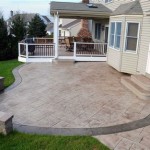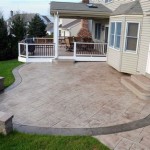How to Refinish Patio Concrete
Concrete patios, while durable and often cost-effective, can suffer from wear and tear over time. Cracking, staining, and surface degradation can diminish their aesthetic appeal and potentially compromise their structural integrity. Refinishing a concrete patio is a worthwhile undertaking that can restore its original beauty and extend its lifespan. This article provides a comprehensive guide on how to refinish a concrete patio, covering preparation, repair, application, and sealing.
Assessing the Existing Concrete
The initial step in any refinishing project is a thorough assessment of the existing concrete surface. This involves carefully examining the patio for any signs of damage, including cracks, spalling (surface flaking), staining, and discoloration. The extent and nature of the damage will dictate the appropriate repair methods and refinishing techniques. Minor hairline cracks may require simple patching, while larger, more extensive cracks may necessitate more involved repair procedures. Similarly, the type of staining present will influence the choice of cleaning agents and stain removal techniques. Understanding the condition of the existing concrete is crucial for a successful refinishing outcome.
Evaluating the overall structural integrity of the concrete slab is also essential. Look for signs of significant shifting, settling, or heaving, which may indicate underlying soil problems or structural issues. If significant structural problems are detected, it may be necessary to consult with a structural engineer or concrete repair professional before proceeding with refinishing. Addressing structural issues prior to refinishing will ensure the longevity and stability of the restored patio.
Visual inspection is often sufficient for initial assessment. However, for more complex situations, consider using tools like a level to check for uneven surfaces or a moisture meter to assess the moisture content of the concrete. High moisture levels can affect the adhesion of refinishing products and lead to premature failure. Proper assessment ensures that the chosen refinishing method is suitable for the patio's condition and prevents future problems.
Preparing the Concrete Surface
Surface preparation is arguably the most important factor in the success of any concrete refinishing project. A clean, sound, and properly prepared surface will ensure optimal adhesion of the refinishing materials and contribute to a durable and long-lasting finish. The preparation process typically involves cleaning, repairing, and profiling the concrete surface.
Thorough cleaning is the first step in surface preparation. This involves removing all dirt, debris, grease, oil, and other contaminants from the concrete. A pressure washer is an effective tool for removing loose debris and surface dirt. However, for tougher stains and contaminants, it may be necessary to use a degreaser or specialized concrete cleaner. Follow the manufacturer's instructions for the specific cleaning product being used, and be sure to rinse the surface thoroughly with clean water after cleaning.
After cleaning, address any existing cracks or damage. Small hairline cracks can often be filled with a concrete crack filler, such as a cement-based patching compound or an epoxy crack filler. Larger cracks may require a more substantial repair, such as routing out the crack and filling it with a concrete repair mortar. Spalled areas should be cleaned and patched with a concrete patching compound. Ensure that the repair materials are compatible with the existing concrete and the chosen refinishing system. Allow the repair materials to cure completely according to the manufacturer's instructions before proceeding.
Finally, profile the concrete surface to promote adhesion. This involves creating a slightly rough texture on the surface to provide a mechanical bond for the refinishing materials. Profiling can be achieved through various methods, including acid etching, grinding, or shot blasting. Acid etching involves applying a diluted solution of muriatic acid to the concrete surface, which etches the surface and creates a rough texture. Grinding involves using a concrete grinder with diamond grinding pads to remove a thin layer of the concrete surface. Shot blasting involves using a specialized machine to propel small steel or abrasive particles at the concrete surface to remove the surface layer. The choice of profiling method will depend on the type of refinishing material being used and the desired level of texture.
Choosing a Refinishing Method
Several refinishing methods can be employed to enhance the appearance and protect a concrete patio. The choice of method will depend on factors such as budget, desired aesthetic, and the condition of the existing concrete. Common options include concrete overlays, staining, painting, and stamping.
Concrete overlays involve applying a thin layer of a cement-based material over the existing concrete surface. Overlays can be applied in various textures and patterns to create a decorative finish. They can also be used to repair minor surface imperfections and provide a new, uniform surface for staining or sealing. Several types of concrete overlays are available, including micro-toppings, self-leveling overlays, and stamped overlays. Micro-toppings are thin overlays that are applied in multiple coats to create a smooth, seamless finish. Self-leveling overlays are designed to flow easily and create a perfectly level surface. Stamped overlays are applied and then stamped with a pattern to create a decorative texture.
Concrete staining involves applying a colored stain to the concrete surface to enhance its appearance. Stains penetrate the concrete and create a permanent color that won't peel or fade. Two main types of concrete stains are available: acid-based stains and water-based stains. Acid-based stains react chemically with the concrete to create a mottled, variegated color. Water-based stains penetrate the concrete and create a more uniform color. Concrete staining is a relatively inexpensive and easy way to add color and character to a concrete patio.
Concrete painting involves applying a paint coating to the concrete surface. While painting is a cost-effective option, it is important to use a concrete-specific paint that is designed to withstand outdoor conditions and resist cracking and peeling. Acrylic latex paints are a popular choice for concrete patios due to their durability and ease of application. Before painting, the concrete surface must be properly cleaned and primed to ensure good adhesion.
Concrete stamping involves imprinting a pattern into freshly poured or overlaid concrete. This creates a textured surface that resembles brick, stone, or other materials. Stamping can be done with a variety of stamps and patterns, allowing for a wide range of design options. Stamped concrete is a durable and aesthetically pleasing option for refinishing a concrete patio.
Applying the Refinishing Material
The application process varies depending on the chosen refinishing method. Regardless of the method, adhering to the manufacturer’s instructions is paramount. This will ensure proper application techniques, drying times, and curing procedures, all crucial for a successful and durable finish.
For concrete overlays, the application typically involves mixing the overlay material with water according to the manufacturer's instructions. The overlay is then applied to the prepared concrete surface using a trowel or squeegee. The thickness of the overlay will depend on the type of overlay being used and the desired finish. For stamped overlays, the pattern is imprinted into the wet overlay material using a stamp. The overlay is then allowed to cure completely before applying a sealer.
For concrete staining, the stain is applied to the prepared concrete surface using a brush, roller, or sprayer. The stain should be applied evenly and allowed to penetrate the concrete for the recommended time. Once the stain has penetrated, the excess stain should be wiped off with a clean cloth. The stain is then allowed to dry completely before applying a sealer.
For concrete painting, the concrete-specific paint is applied to the prepared and primed concrete surface using a brush, roller, or sprayer. Apply two or more coats of paint, allowing each coat to dry completely before applying the next coat. Ensure the paint is thoroughly cured before exposing the patio to heavy traffic or the elements.
Sealing the Refinished Concrete
Sealing the refinished concrete is a crucial step in protecting it from the elements and extending its lifespan. A concrete sealer creates a protective barrier that prevents water, oil, and other contaminants from penetrating the concrete and causing damage. Several types of concrete sealers are available, including acrylic sealers, epoxy sealers, and polyurethane sealers.
Acrylic sealers are a popular choice for concrete patios due to their ease of application and affordability. They provide good protection against water and UV damage, but they are not as durable as epoxy or polyurethane sealers. Epoxy sealers are more durable than acrylic sealers and provide excellent protection against water, chemicals, and abrasion. However, they can be more difficult to apply and may require specialized equipment. Polyurethane sealers are the most durable type of concrete sealer and provide excellent protection against water, chemicals, abrasion, and UV damage. However, they are also the most expensive type of sealer and may require professional application.
Before applying the sealer, ensure that the refinished concrete surface is clean and dry. Apply the sealer according to the manufacturer's instructions, using a brush, roller, or sprayer. Apply two or more coats of sealer, allowing each coat to dry completely before applying the next coat. Allow the sealer to cure completely before exposing the patio to heavy traffic or the elements. Reapply the sealer every one to two years to maintain its protective properties.

3 Concrete Resurfacing Options For Patio

Resurfacing A Concrete Patio For Budget Diy Makeover Fab Everyday

Refinishing Old Pitted Concrete Patio

Concrete Resurfacing Tutorial Countertop Experts

Concrete Resurfacing Restaining Northwest Ar Nwa Floors

Concrete Stain And Sealer Patio Makeover Exchange

3 Concrete Resurfacing Options For Patio

Concrete Resurfacing Long Island Infinity Floors Best Contractor In The Tri State

Resurface And Patch Concrete Surfaces

How To Paint A Concrete Porch Or Patio
Related Posts








